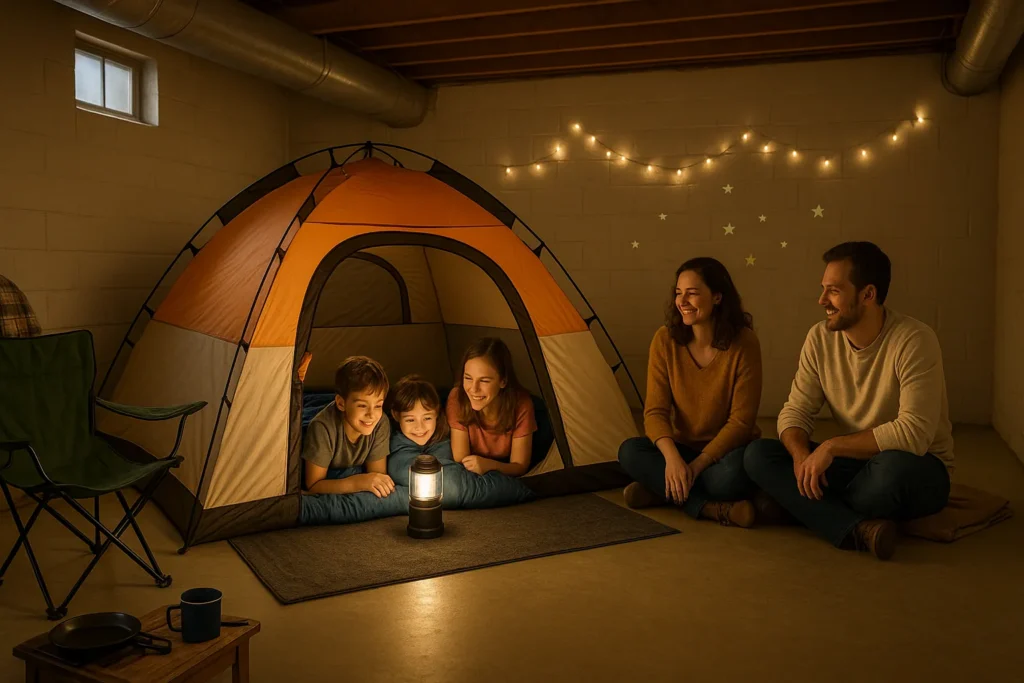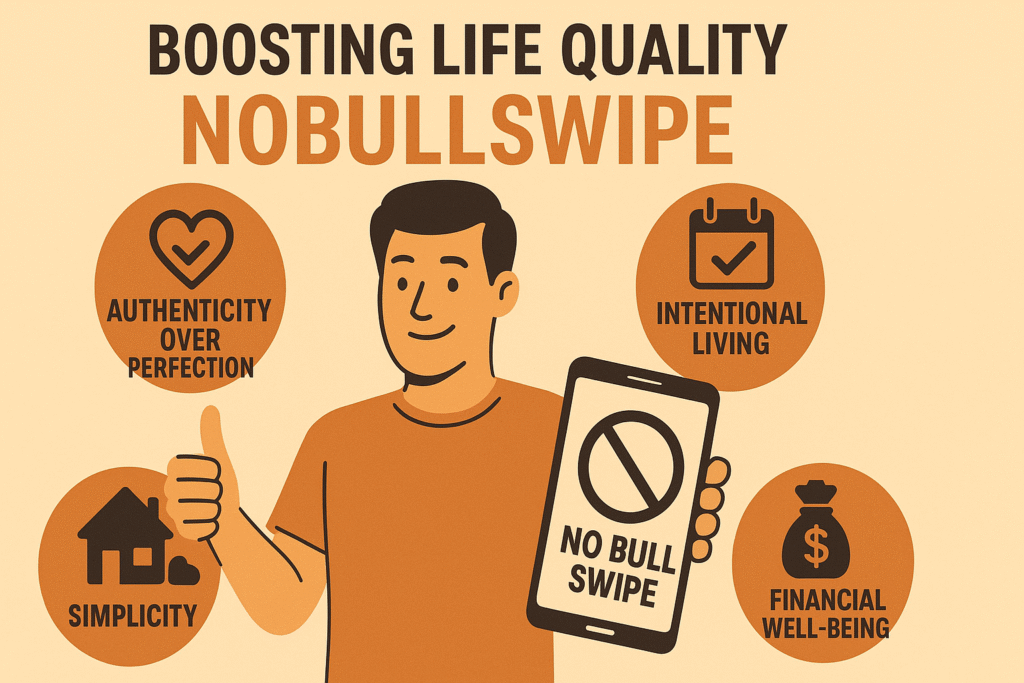If you’ve ever dreamed of going camping but the weather or your schedule got in the way, basement camping is your perfect solution. It’s camping without bugs, rain, or packing stress — just fun, warmth, and creativity right at home.
Here’s the thing: a basement can transform into a cozy little adventure space with the right setup. Whether you’re doing it with kids, your partner, or even solo for a chill weekend escape, basement camping is a clever way to unplug and reconnect.
Let’s go step by step through how to plan, decorate, and enjoy your own indoor camping trip — all while keeping it safe, simple, and memorable.
Snippet-Ready Definition:
Basement camping is a creative indoor activity where you set up a tent or fort in your basement, recreating the camping experience with lights, sleeping bags, and fun games—without leaving home.
What Is Basement Camping and Why It’s So Popular
Basement camping is exactly what it sounds like — creating a full camping experience right inside your basement. You can set up a tent, lay out sleeping bags, and even simulate a campfire with flashlights or LED lights.
The best part is that it combines the excitement of camping with the comfort of home. You don’t need to worry about rain, mosquitoes, or forgotten gear. Kids love the sense of adventure, and adults enjoy the break from screens and routines.
Think of it as your private escape zone — perfect for rainy days, family nights, or winter weekends when outdoor camping just isn’t possible.
Choosing the Perfect Spot in Your Basement
Before you start setting up, find the best corner of your basement. Choose a space that’s dry, well-ventilated, and has enough room to move around. If your basement has windows or vents, open them a bit to keep the air fresh.
Avoid spots that feel damp or smell musty. A small dehumidifier or air purifier can help if your basement tends to trap moisture. Air quality matters more than you’d think — especially if you’re spending the night there.
Pro tip: If your basement floor is concrete, spread a thick rug or foam mats under your tent or blankets. It makes the space warmer and softer to sleep on.
Gather Your Basement Camping Gear
Now, let’s talk about what you’ll need. You don’t have to buy fancy equipment, but a few basics make all the difference:
- A small tent or fort made from blankets and chairs
- Sleeping bags or thick comforters
- Flashlights or LED lanterns
- Pillows and throws for extra comfort
- Extension cord for lighting or charging
If you want to go the extra mile, grab a few pieces from your local sports basement camping section. A foldable camping chair, portable light, or even a sports basement camping stove (electric version) adds authenticity.
You can also look into sports basement camping rentals for short-term gear — it’s an affordable way to try new setups without cluttering your home.
Setting Up Your Indoor Campsite
This is where the fun begins. Decide whether you want a tent setup or a homemade fort. For younger kids, blanket forts are pure magic — they love crawling inside and pretending they’re deep in the woods. For adults or families, a 6-person tent fits perfectly in many basements and makes it feel like a true mini campsite.
When you’re setting up, organize your area into little zones:
- Sleeping zone: where the tent or bedding goes
- Snack zone: a small table with food, drinks, and board games
- Storage zone: keep camper basement storage ideas in mind to stay organized
Use bins or baskets for your basement camping equipment. Label them “gear,” “snacks,” or “games” to make setup and cleanup faster.
Creating the Right Mood and Atmosphere
Basement camping is all about vibe. Turn off the main lights and use softer ones like fairy lights, battery candles, or LED lanterns. You can even stick glow-in-the-dark stars on the ceiling for that “sleeping under the stars” feeling.
For sound, play gentle outdoor noises — crickets, campfire crackles, or forest sounds. Many free apps and playlists are made just for that.
Here’s the thing: the smell makes a difference too. You can use a campfire-scented candle or diffuser to bring in that cozy, woodsy aroma. Just be safe — no real flames, please. If you want a hint of smokiness, try a small cocktail smoker for effect (without heat or fire).
Food, Snacks, and Camp Cooking Ideas
You can’t call it camping without good food. Luckily, indoor camping meals are the easiest to make.
Start simple with snacks like popcorn, trail mix, or marshmallows dipped in chocolate. For the main treat, make microwave s’mores — they’re quick, gooey, and bring the campfire spirit home.
If you’re cooking, use a countertop grill or electric pan to prepare easy camping meals like:
- Hotdogs and wraps
- Mini burgers
- Foil-pack veggies or potatoes
Serve everything on sports basement camping plates or enamel-style dishes to make it feel like a real camp. Spread a picnic blanket and enjoy dinner “under the stars” in your cozy indoor campsite.
Activities That Make Basement Camping Unforgettable
Once you’ve eaten, it’s time for fun. Here are a few ideas that turn your basement camp into an adventure:
- Tell spooky or funny stories around the flashlight “campfire.”
- Play shadow puppets on the tent wall.
- Host a movie night — project your favorite outdoor movie on a blank wall.
- Try a glow-in-the-dark treasure hunt with hidden clues.
- Have a family game tournament with cards or board games.
If you have kids, let them take charge of one activity. It gives them ownership and boosts their creativity. You can even use ideas from Leonardo’s Basement summer camp style projects — like building small DIY lanterns or nature-themed crafts.
Safety and Comfort Come First
Even though it’s indoors, camping safety still matters. Always keep flashlights handy and avoid real flames. A small battery lantern or electric fireplace can give that campfire glow safely.
Make sure cords aren’t stretched across the floor where someone could trip. Keep electronics away from water or damp spots. If you’re using heaters, use them sparingly and only those designed for enclosed spaces.
Comfort is just as important. Layer your bedding to stay warm, especially if your basement gets chilly at night. Sleeping bags over thick blankets work great. Add a few pillows and plush throws to make it extra cozy.
Air Quality and Moisture Control
Basements can sometimes get humid, and that’s something you’ll want to manage before camping there. A dehumidifier helps keep the air fresh and prevents mold. You can also place moisture-absorbing silica gel packets around your gear.
If your basement tends to trap air, crack open a small window or run an air purifier. Fresh air makes sleeping much more comfortable.
Here’s another little tip: check your gear after each camp night. If blankets or sleeping bags feel damp, wash or dry them before storage. It keeps them fresh for the next adventure.
Storing and Organizing Your Gear
If you plan to make basement camping a regular thing, you’ll love organizing your gear smartly. Use airtight bins or vacuum bags to store sleeping bags, mats, and cushions. Label each one so setup takes just minutes next time.
Add a few shelves or cabinets for camper basement storage. Hooks on the wall can hold lanterns or backpacks. When you mix function with style, your basement looks organized even between camp nights.
Many families turn one corner of their basement into a semi-permanent camp zone — complete with twinkle lights and cozy rugs. It’s perfect for spontaneous weekend fun.
Themed Basement Camping Nights
Want to make things even more exciting? Try themed camps. A few popular ones include:
- Family adventure night: everyone shares stories of dream destinations.
- Spooky Halloween camp: dim lights, ghost stories, and glow sticks.
- Winter cabin retreat: cozy socks, hot cocoa, and flannel blankets.
For kids, themed nights can become magical. Use ideas from Leonardo’s Basement summer camps — like building small science projects, creating “firefly jars,” or designing paper tents. You can mix fun and learning easily when you’re creative.
Expert Tips for a Better Experience
After trying a few rounds of basement camping myself, I’ve learned a couple of tricks that make things even smoother:
- Test all your gear before you start (flashlights, batteries, fans).
- Keep a small first-aid kit nearby — just in case.
- Use floor cushions instead of chairs for a cozier feel.
- Bring along a small Bluetooth speaker for music or white noise.
And guess what? You can use your sports basement camping chairs indoors too. They’re light, comfortable, and add to the real-camp feel.
If you don’t own camping gear, check out sports basement camping rentals in your area. They usually offer affordable short-term rentals for tents, chairs, and lanterns.
Eco-Friendly and Budget Ideas
You don’t have to spend much to create an amazing setup. Use what you already have — old sheets, cushions, string lights, and a little imagination.
Recycling and repurposing household items not only saves money but also keeps your setup sustainable. Avoid disposable plastic items; instead, use reusable camping plates and cups.
If you want to invest, buy one or two multi-purpose pieces — like a foldable tent or LED lantern — that can also be used for backyard camping later.
Common Mistakes to Avoid
Here are a few things that can ruin the fun if you’re not careful:
- Ignoring ventilation — fresh air is essential.
- Using candles or any open flame indoors.
- Overcrowding the space — keep some room to move.
- Forgetting comfort items like extra blankets or cushions.
A little planning goes a long way to ensure everyone has a good time without discomfort or risk.
The Feel-Good Benefits of Basement Camping
Beyond the setup and fun, basement camping has surprising emotional benefits. It helps families reconnect, teaches kids creativity, and gives adults a mental break from screens and stress.
It’s an easy way to build happy memories. There’s something special about turning off the lights, curling up inside a fort, and telling stories by flashlight glow. It brings back a sense of wonder we often lose as grown-ups.
For solo campers, it’s a peaceful form of self-care — a mini retreat without leaving home.
Step-by-Step Guide: How to Set Up Basement Camping
- Pick a dry, clean spot in your basement with good airflow.
- Lay a soft base using rugs or foam mats for comfort.
- Set up your tent or fort using chairs, sheets, or a 6-person tent.
- Add cozy essentials: sleeping bags, pillows, LED lanterns, and snacks.
- Decorate with lights and glow-in-the-dark stars for a starry vibe.
- Play camping sounds or tell stories around a flashlight “campfire.”
- Keep it safe: no real fires, use dehumidifiers for fresh air.
Comparison Table: Basement Camping vs Outdoor Camping
| Feature | Basement Camping | Outdoor Camping |
| Location | Indoors, in your basement | Outdoors, at campsites or parks |
| Weather Risks | None – completely weather-proof | High – depends on rain, wind, bugs |
| Setup Time | 15–30 minutes | 1–2 hours |
| Comfort Level | Very comfortable, home access | More rugged, nature-based |
| Safety | Safe, controlled environment | Must follow outdoor safety rules |
| Best For | Families, kids, cozy nights | Nature lovers, adventure trips |
FAQs About Basement Camping
Why is stealth camping illegal?
Stealth camping is often illegal because it involves staying overnight in places not designated for camping, such as private property or city areas. It raises safety and trespassing concerns.
Is it safe to sleep in the basement?
Yes, it’s safe if your basement is dry, clean, and well-ventilated. Use a dehumidifier, check for mold, and keep an emergency exit clear for safety.
What is the 200 rule for camping?
The 200-foot rule means you should camp at least 200 feet away from water sources or trails in the wild. It protects natural habitats and reduces environmental impact.
What is lazy camping?
Lazy camping means keeping camping simple—minimal setup, ready-made food, and easy entertainment. Basement camping often fits this style because it’s low-effort and comfortable.
What is boondocking?
Boondocking is camping without hookups or amenities, usually in remote areas. It’s the complete opposite of basement camping, which offers all the comforts of home.
Is it illegal to just camp anywhere?
Yes, most areas have camping restrictions. Always check local laws and property rules before setting up. Basement camping avoids this problem since it’s on your own property.
Wrapping Up: Turn Your Basement Into an Indoor Getaway
Here’s the truth — you don’t need fancy mountains or beaches to enjoy the thrill of camping. With a few blankets, a bit of imagination, and your own basement, you can create a world of fun.
Basement camping brings families together, sparks creativity, and reminds us that adventure is all about mindset. So, next time it rains or you just want a cozy night in, turn off the lights, grab your flashlight, and head downstairs.
You might be surprised how magical your basement can feel.
Disclaimer
This article is for informational and recreational purposes only. Always ensure proper ventilation and safety when camping indoors. Avoid open flames or gas equipment inside enclosed spaces. The author and Out of Magazine are not responsible for any accidents or misuse of equipment during indoor camping activities.

Hi, I’m Bilal, the founder of outofmagazine.com. I love sharing fresh ideas, stories, and helpful insights on all kinds of topics that spark curiosity. My goal with this site is simple—to create a space where readers can find inspiration, useful tips, and engaging reads on lifestyle, trends, and everything in between.



